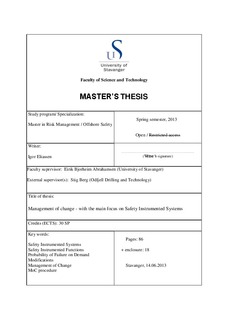| dc.description.abstract | Safety instrumented systems (SISs) are implemented in the oil and gas industry to detect the onset of hazardous events, and/or to mitigate their consequences. As with any system, for different reasons, modifications are necessary. If the modification is poorly executed, or if the risk is poorly understood, the modification may have undesired consequences.
The main objective of this master thesis was to identify potential pitfalls that may result from poor change management of modifications, and propose recommendations on how to handle these pitfalls. In addition to the main objective, two sub-objectives were supplemented to contribute to discussion and recommendations for the main objective.
For the first sub-objective, a case was presented. The main purpose of this case was to illustrate how different modifications might affect the calculated PFD, and if the calculated values are sufficient to express the extent of the modification. As it became apparent in the discussion chapter, one cannot rely solely on the calculated PFD value. These values can provide useful insight for the decision maker; however, it is important to look beyond the assigned probabilities, since the probabilities may camouflage uncertainties. The circumstances should always be assessed in addition to the calculated PFD.
The second sub-objective was to propose a simple alternative approach on how to classify the modifications to SIS in modification project. The main findings suggest that there is a need for an alternative description on what should be considered as minor and major modifications in SIS modification projects. This thesis proposes an alternative way of categorizing modifications, where four categories are used to express the safety significance of the modification. To aid in the categorization, a checklist consisting of several conditions (questions) is presented. The main purpose of this checklist is to provide an overview of the impact the proposed modification has on the system, and the risk level before the categorization.
To cover the latent functional relationships, failure modes and impacts of modifications, the modification process should be well structured and documented. Several risk and safety assessments should be included as early as possible to ensure that potential problems are identified, and appropriate measures implemented as early as possible. This thesis proposes a management of change procedure in form of a flowchart. This flowchart is based on the identified issues and the requirements in the ISO-9001 standard. The main purpose of the proposed procedure is to ensure that the modifications to SIS, or any other part of the facility are under control, and that the safety is not compromised. Furthermore, the procedure aids in providing traceability during, and after the modification process. | no_NO |
